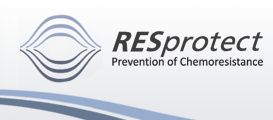AACR-NCI-EORTC International
Conference November 17-21st, 2003 - Development of efficient drugs for the treatment of the “polygenic” phenomenon of chemoresistance

Rudolf Fahrig1, Jörg-Christian Heinrich1, Christian Praha1, Falk Wilfert1, Georg Krupitza2, Denise Sonntag1, Detlef Quietzsch3, Mathias Hänel3
1RESprotect GmbH, Dresden/Germany, 2Institute of Clinical Pathology, University of Vienna/Austria, 3Klinikum Chemnitz Hospital, Department of Hematology, Oncology, Chemnitz /Germany.
Currently, the mechanistic approach of genomics relies on "monogenic" targets. A validated target is usually gene or gene product, which is either over-expressed or over-activated in a disease tissue. Enzyme inhibitors or receptor antagonists may suppress this improper activation, thus reducing the symptoms of a disease. However, most diseases are not caused by a "monogenic" disorder, instead, multiple genes contribute to the pathophysiology. Therefore, disease usually have a "polygenic" background. To treat a "polygenic" phenomenon like chemoresistance, it is necessary to control multiple genes and their products simultaneously. Chemogenomics, the approach of RESprotect, bases on the application of small synthetic molecules, which elicit favourable phenotypic changes. The combination with genomic tools focussing on specific biological pathways qualifies us to understand th broader effect of a drug. That way, it is possible to discover drugs that treat the cause of a disease rather than its symptoms. Reasons for the suppression of cytostatic drug-induced apoptosis are overexpression of oncogenes like DDX1, STAT3, JUN-D, DNA repair genes like APEX, UBE2N, and other survival pathways, but down-regulation of DT-diaphorase and caspases. RP101 antagonized these effects induced by cytostatic drug treatment. Beyond that, during recovery, when treatment was continued with RP101 only, microfilamental proteins were upregulated, proteins involved in ATP generation or cell survival were downregulated. That way, the anti-tumor efficiency of chemotherapy was optimized, and toxic side effects were reduced.
|






